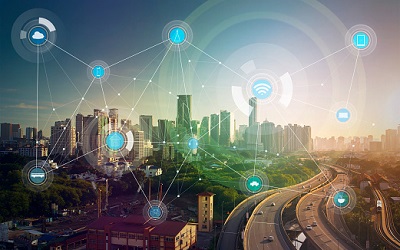Whether or not you realize it, you’ve probably used the Internet of Things (IoT) in a number of different ways. Put simply, the IoT refers to the connecting of any device to the internet (or to other devices). This means that everyday objects—cars, coffee makers, refrigerators—are connected to the internet, and possibly to each other. Think of all the appliances, devices, and tools you use every day. At some point, they may be connected to the IoT.
The IoT dates back to 1974, when ATMs were first introduced. Since then, developers have worked to incorporate this technology into every aspect of life, from your phone to your car to your home.
According to some projections, by the year 2020, the IoT will comprise up to 200 billion items. Each of these “smart objects” will come with various pros and cons, opportunities and risks.
Here are some examples you might already be familiar with:
Around Your Home
Thermostats: Nest makes several different household items, such as a thermostat that you can control from your phone even when you’re at work, and that can learn your heating and cooling preferences over time.
Smoke and carbon monoxide alarms: The same company makes alarms that can send warning signals to your phone. These smart alarms can also communicate with other household devices: Heating systems can sometimes make smoke or carbon monoxide emergencies worse by spreading them around the house through the ventilation system. Nest alarms can work with Nest thermostats to turn off the heat in case of an emergency. These systems can even “speak” out loud—so if you’re in one room and there’s smoke in another, your alarm can tell you where the smoke is coming from.
Refrigerators: The Samsung Family Hub uses a mobile app to let you see what’s in your fridge no matter where you are, sends you alerts when things are about to spoil and lets you order groceries through the refrigerator’s built-in tablet.
Coffee pots: If you feel very passionately about your morning Joe, a smart coffee pot can let you check the water levels in your machine and start brewing coffee while you’re still in bed. Some can even use your location, kicking on when you reach a set geographical landmark, such as when you’re on your way home from the gym.
In Your Car
Wi-Fi on the go: An increasingly in-demand feature for new vehicles is Wi-Fi connectivity. This might seem like simple internet access, but the fact that your car is connected means that it’s part of the IoT.
Heads-up displays: These displays project transparent digital images on the car’s windshield so that you can see information—like your speed, engine data, weather reports and even incoming emails—without taking your eyes off the road.
Actual self-driving cars: Driverless vehicles are not just a futuristic fancy. A few years ago, Uber launched a small fleet of self-driving vehicles in Pittsburgh through a partnership with Volvo. With every major car manufacturer chomping at the bit to join the movement, forecasters say we’ll see the global self-driving vehicle market grow from 20.3 million units in 2021 to 62.4 million units by 2030.
On Your Body
Fitness trackers: There’s a good chance that you’ve already dabbled with a health tracker (e.g., FitBit), or at least played with your phone’s built-in pedometer. The promise of these tools is accountability, first and foremost, as they can track your steps and activity levels during the day, allowing you to modify your fitness behavior over time.
Smart watches: Thanks to Apple’s creative advertising team and robust budget, you’ve almost definitely heard of the smart watch that lets you access your phone with the flick of your wrist.
Coming soon: Every year, Silicon Valley introduces more and more devices to the IoT. In the not so distant future, there’s a good chance that most of us will own clothing that connects to the internet. Potential perks include tracking down lost items, finding exact replacements when your clothing becomes worn out, and accessing related information, like washing instructions and fashion tips.
But Is It Safe?
Yes, having devices that offer limitless access to information can help us simplify or improve our lives. However, the more IoT-connected devices you use, the more you’re sharing your personal data with the world. Some of this data might be used by marketers who are trying to sell you related products and services.
But, there are also security concerns to consider. If your refrigerator can use your internet connection to order milk or send consumer feedback to the Samsung headquarters in South Korea, it can be used by online entities to gain access to the other devices on your network. As a result, it’s important to learn about your devices’ vulnerabilities and how to safeguard against any breaches.
You might think, “Who cares if someone wants to hack my coffee maker?” But remember that your coffee maker is also connected to your smartphone, your home’s internet, and ultimately your private data. As devices start to learn your routines, intruders can gain access to that information as well.
How would you feel if data from your calorie- and weight-tracker became common knowledge? Do you really want a hacker to tap into your car’s GPS to learn every location you visit? Access to your lifestyle habits and personal information could provide burglars with enough information to invade your home unencumbered.
Depending on how connected your home is, hackers might even be able to remotely unlock your home or disable security cameras. Intruders with this kind of access could easily restore normal functionality after your things are gone, and no one would be the wiser.
Ransomware, in particular, enables intruders to prevent victims from accessing important data or files until they pay a ransom for their release. Having your personal files in the hands of strangers is disconcerting enough, but there is no way to guarantee that you’ll regain access to your data even if you pay the ransom.
How Can You Protect Yourself?
There are a number of ways you can safeguard yourself without swearing off the IoT entirely:
Passwords: The simplest way to protect yourself and your information is to password protect your devices. Aim to create a strong password and do not share it with anyone. Remember that different devices should have different passwords.
Protect your network: As you connect more devices to your home network, it’s important to install network protection software. The Federal Communications Commission has laid out detailed guidelines on how to protect your home network. Top tips include:
- Creating unique usernames and passwords for all your accounts
- Connecting through secure (https) websites
- Using your cellphone data instead of public Wi-Fi to transmit sensitive information
- Turning off your phone’s Wi-Fi auto-connect setting
Install anti-virus software: Most of us know to install some form of anti-virus software on our computers and laptops. You should also do so with your phones, tablets, and other connected devices whenever possible. They have access to the same internet that your computer does—which means they have many of the same risks and vulnerabilities.
Update your software: Prompts to update your software may seem like continuous interruptions, but software updates often fix vulnerabilities on your devices.
Read the fine print: Every device, app and web account will present you with some kind of terms and conditions that you must agree to before use. Read them. They’ll help you understand what data are being collected and allow you to protect yourself from divulging too much information to inane sources.
The IoT can be a wonderful and useful tool to make your life simpler and more convenient, but as with any technology, you should understand what you are getting yourself into. Consider how connected you really need to be. Remember, each linked device is a potential gateway for intruders—so if you can forgo the geofencing-enabled coffee maker and just set a timer, maybe that’s the better option. But either way, as you get connected, make sure you also get protected.
Keep Reading: The Kitchen of the Future






